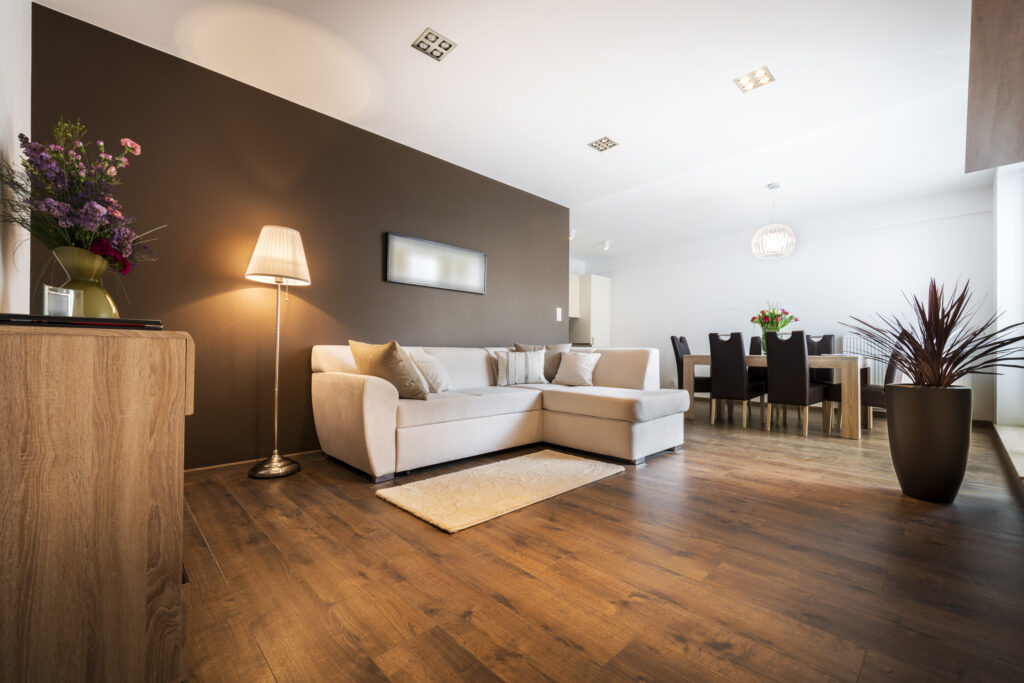
Choosing the perfect flooring for your home can be a challenging decision, especially when considering the options of hardwood and engineered flooring. Both types offer distinct advantages and considerations, and understanding their differences can help you make an informed choice that aligns with your preferences and needs.

Hardwood flooring is made of solid wood, such as maple, oak, or walnut, and is known for its timeless beauty and natural charm. Its long lifespan allows for multiple sanding and refinishing processes, maintaining its appearance over time.

Hardwood floors are unmatched in their natural beauty, with each plank showcasing unique grain patterns, colors, and textures. They add sophistication and enhance the aesthetic appeal of any space.
Hardwood flooring is highly durable and can withstand heavy foot traffic and daily wear and tear. Properly maintained, hardwood floors can last for generations. They can also be refinished multiple times, extending their lifespan.
Cleaning and maintaining solid hardwood floors is relatively easy, requiring sweeping, vacuuming, and occasional mopping with a special wood cleaner. Avoid using water or steam for cleaning.
While the natural variations of hardwood floors add character, they can also be a drawback. Hardwood is prone to expansion and contraction due to humidity changes, which may cause gaps or warping. It is also susceptible to scratches and dents, especially in high-traffic areas.
Engineered wood flooring closely resembles hardwood on the surface, but it is constructed differently. It consists of a high-quality plywood core with a thin layer of hardwood flooring on top. Engineered flooring is a more affordable option but cannot be refinished as often as hardwood flooring.

Engineered flooring is designed to combat the limitations of solid hardwood. Its layered construction minimizes the effects of humidity and temperature fluctuations, making it more stable and less prone to expansion and contraction. It is suitable for areas with fluctuating moisture levels, like basements and bathrooms.
Engineered wood flooring requires similar maintenance to hardwood, with sweeping, vacuuming, and occasional mopping. Most engineered wood floors cannot be sanded and refinished as often as hardwood. They can be refinished once or twice before needing plank repairs.
Engineered flooring offers flexibility in installation methods, including gluing, nailing, or floating, depending on project requirements. This versatility allows for easy installation over various subfloor types.
Engineered flooring comes in a wide range of finishes, species, and styles, allowing you to achieve your desired aesthetic. It is typically more budget-friendly than solid hardwood, making it an excellent choice for those seeking an affordable yet stylish flooring option.
Here is a comparison table of different aspects that can help you make an informed decision.
Solid wood boards of hardwood.Water-resistant, but not waterproof.
Composed of multiple layers, with a top layer of hardwood veneer. More water-resistant than hardwood, but not waterproof.
Typically more expensive. Between $8 and $15 per square foot.
Generally more affordable. Between $4 to $7 per square foot.
Highly durable with proper care. Lifespan around 30 to 100 years.
Resistant to warping and moisture. Lifespan up to 30 years or more.
Prone to expansion and contraction.
More stable due to layered construction
Can be sanded and refinished multiple times.
Limited number of times it can be sanded.
Classic look with natural variations.
Similar aesthetic to hardwood, with narrower options.
Made from a renewable resource, with deforestation concerns.
Uses less hardwood, reducing impact on forests.
Please note that the provided information is a general overview, and specific products and manufacturers may have variations. Consider your individual preferences, budget, and space conditions when deciding between hardwood and engineered floors.
In summary, hardwood and engineered wood floors are often interchangeable in most homes, with more similarities than differences. However, engineered wood flooring is a better choice for high-moisture environments and offers a wider range of style choices. Budget and style preferences are important factors to consider when making your decision.